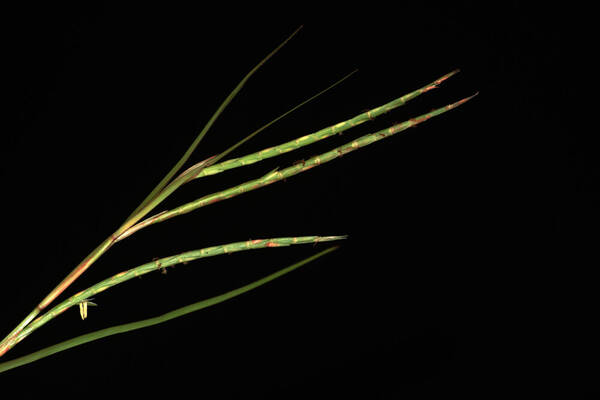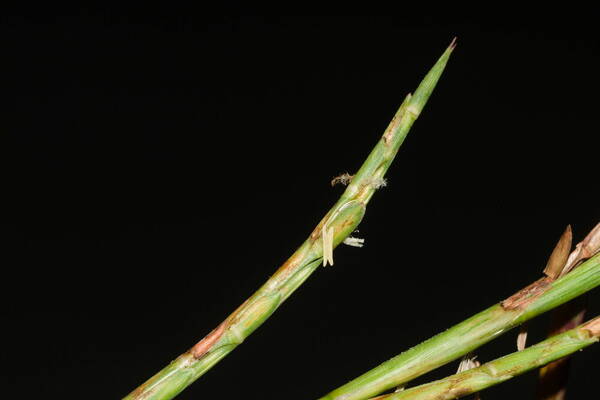Info
Subfamily: Panicoideae
Genus etymology: Hemarthria = "half segment" [Greek] refering to the inflorescence branches which break into segments at maturity
Species etymology: altissima = "most tall" [Latin] refering to the height compared to related species
Photosynthetic type: C4 (warm season)
Nativity: naturalized - intentional
First recorded in Hawaiʻi: 1990
Map

Inflorescence




Plant






Habit


Spikelets







Node

Collar

Description
Stoloniferous perennial; culms up to 2.5 m. long and 2–4 mm. in diameter, prostrate and rooting at the nodes below. Leaf-blades flat, 5–15 cm. long, 3–4 mm. wide. Racemes 4–10 cm. long, mostly borne singly in the axils and exserted from the axillary sheath. Sessile spikelet elliptic-oblong with a triangular callus; lower glume 4–6 mm. long, with or without a constriction near the apex, obtuse to emarginate; upper glume obtuse to acute. Pedicelled spikelet narrowly triangular, 4–6 mm. long, truncate at the base without a callus, subacute to acute at the tip.
(Description source: Clayton, W.D. & Renvoize, S.A. 1982. Flora of Tropical East Africa. Gramineae (Part 3). A.A. Balkema, Rotterdam. 448 pp. )
Stoloniferous perennial; culms up to 250 cm long and 2–4 mm in diameter, prostrate and rooting at the nodes below. Leaf laminas 5–15 cm × 3–4 mm, flat. Racemes 4–10 cm long, mostly borne singly in the axils and exserted from the axillary sheath. Sessile spikelet elliptic-oblong, with a triangular callus; inferior glume 4–6 mm long, with or without a constriction near the apex, obtuse to emarginate at the apex; superior glume obtuse to acute at the apex. Pedicelled spikelet narrowly triangular, 4–6 mm long, truncate at the base and without a callus, subacute to acute at the apex.
(Description source: Cope, T.A. (ed.). 2002. Flora Zambesiaca. Volume 10. Part 4. Kew, London. 190 pp. )
Plants perennial; rhizomatous and/or stoloniferous. Culms 30-150 cm, erect to ascending, flattened. Leaves basal and cauline; sheaths mostly glabrous, margins sparsely ciliate basally, scabrous distally; ligules 0.2-1 mm; blades flat to conduplicate, glabrous, margins ciliate basally. Rames 2-10 cm, erect. Sessile spikelets: lower glumes 4-5 mm, 10-15-veined, lateral veins distinct, margins scarious, apices acute; upper glumes smooth, hyaline to membranous, acute; anthers 3. Pedicels 4-5 mm. Pedicellate spikelets 4-7 mm, acuminate. 2n = 20, 36.
(Description source: Barkworth, M.E., Capels, K.M., Long, S. & Piep, M.B. (eds.) 2003. Flora of North America, north of Mexico. Volume 25. Magnoliophyta: Commelinidae (in part): Poaceae, Part 2. Oxford University Press, New York. 783 pp http://floranorthamerica.org/Hemarthria_altissima )